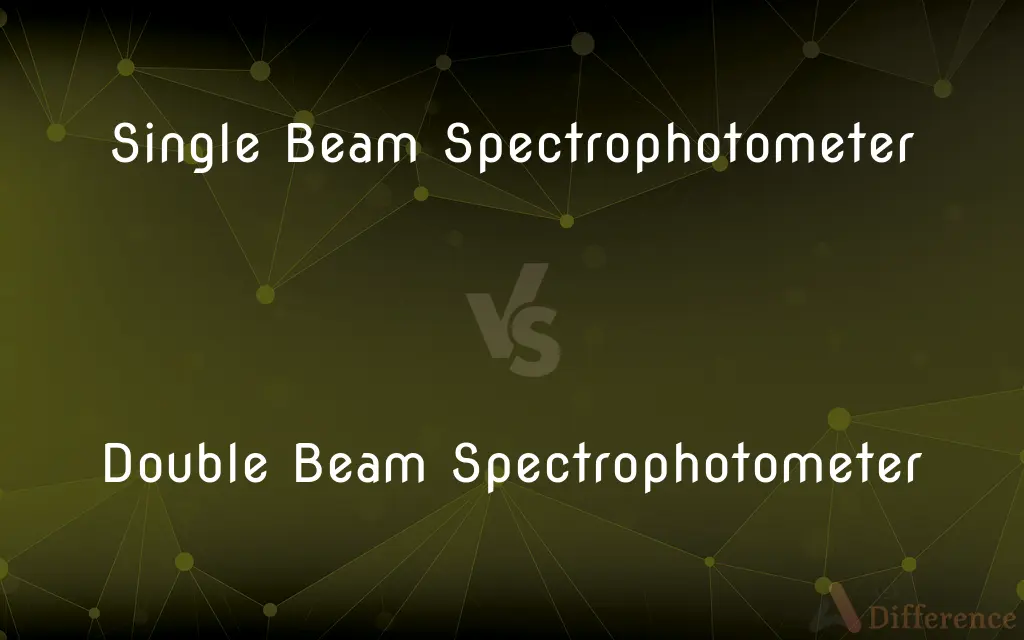Single Beam Spectrophotometer vs. Double Beam Spectrophotometer — What's the Difference?
By Tayyaba Rehman — Published on January 12, 2024
A single beam spectrophotometer measures light intensity before and after a sample is introduced, whereas a double beam spectrophotometer measures the reference and sample simultaneously, offering more accurate and stable results.

Difference Between Single Beam Spectrophotometer and Double Beam Spectrophotometer
Table of Contents
ADVERTISEMENT
Key Differences
A single beam spectrophotometer passes light through a sample, measuring the intensity of light before and after the sample to determine absorbance. In contrast, a double beam spectrophotometer splits the light into two paths—one through the reference and the other through the sample, measuring both simultaneously.
The single beam spectrophotometer requires manual adjustment and comparison between the sample and the reference, leading to more time consumption and potential for error. Double beam spectrophotometers automatically compare the light intensity between the sample and reference, enhancing accuracy and repeatability.
In terms of design, single beam instruments are generally simpler and more compact, making them less expensive and easier to maintain. Double beam spectrophotometers, though more complex, offer greater stability and are less susceptible to fluctuations in light source intensity.
The single beam spectrophotometer is often used in educational and small-scale laboratory settings due to its simplicity and lower cost. Double beam spectrophotometers are preferred in research and industrial settings for their precision and ability to handle a wide range of samples and conditions.
When considering the application, single beam spectrophotometers are suitable for straightforward, less frequent measurements. Double beam spectrophotometers are better for extensive, continuous, or highly accurate measurements.
ADVERTISEMENT
Comparison Chart
Measurement Process
Sequential measuring of sample and reference
Simultaneous measurement of sample and reference
Accuracy
Less accurate, prone to error
More accurate, stable readings
Complexity
Simpler, more compact design
More complex, but offers more consistent results
Cost
Generally less expensive
More expensive due to advanced design
Ideal Use
Education, simple laboratory tests
Advanced research, continuous measurements
Compare with Definitions
Single Beam Spectrophotometer
Requires manual adjustment between sample and reference.
Adjusting the single beam spectrophotometer for each sample was time-consuming.
Double Beam Spectrophotometer
Simultaneously measures sample and reference paths.
The double beam spectrophotometer provided quick, accurate results.
Single Beam Spectrophotometer
Suitable for less frequent, straightforward measurements.
For occasional testing, the single beam spectrophotometer is adequate.
Double Beam Spectrophotometer
Ideal for continuous or advanced measurements.
Continuous monitoring required the use of a double beam spectrophotometer.
Single Beam Spectrophotometer
Generally more affordable.
Small labs often prefer single beam spectrophotometers due to their lower cost.
Double Beam Spectrophotometer
Less susceptible to light source fluctuations.
The double beam design ensured consistent results despite light source variations.
Single Beam Spectrophotometer
Measures light intensity through a sample sequentially.
We used a single beam spectrophotometer for our basic chemistry lab.
Double Beam Spectrophotometer
Offers more stable and precise readings.
For detailed analysis, we rely on the double beam spectrophotometer.
Single Beam Spectrophotometer
Simpler and more compact in design.
The lab chose a single beam spectrophotometer for its ease of use.
Double Beam Spectrophotometer
More complex and expensive.
The lab's budget allowed for a high-end double beam spectrophotometer.
Common Curiosities
What is a single beam spectrophotometer?
An instrument that measures light intensity through a sample in a sequential manner.
How does a double beam spectrophotometer work?
It splits light into two paths to simultaneously measure sample and reference.
Can a single beam spectrophotometer handle complex samples?
It's less ideal for complex or continuous measurements.
Are single beam instruments more portable?
Typically, they are more compact and portable.
Are double beam spectrophotometers faster in operation?
Yes, due to simultaneous measurement.
Can both types of spectrophotometers measure UV light?
Yes, both can be designed to measure UV, visible, and IR light.
Which is more accurate, single or double beam?
Double beam spectrophotometers are generally more accurate.
Do double beam spectrophotometers require more training to operate?
Yes, due to their complexity and advanced features.
Why would a lab choose a single beam spectrophotometer?
For its simplicity, compact size, and lower cost.
Is the double beam spectrophotometer suitable for educational purposes?
It can be used, but its complexity and cost might be excessive for basic education.
What applications are double beam spectrophotometers best for?
They are ideal for advanced research, quality control, and continuous monitoring.
What kind of maintenance does a single beam spectrophotometer require?
Regular calibration and cleaning, but generally easier maintenance due to simplicity.
Which spectrophotometer is better for quick measurements?
Double beam spectrophotometers are quicker for measurements.
Is cost a significant factor in choosing between the two?
Yes, cost is a major consideration, with single beam spectrophotometers being more budget-friendly.
Do both spectrophotometers use the same light sources?
Generally, yes, but the configuration and control might differ.
Share Your Discovery

Previous Comparison
Club Soda vs. Soda Water
Next Comparison
Milk vs. Soy MilkAuthor Spotlight
Written by
Tayyaba RehmanTayyaba Rehman is a distinguished writer, currently serving as a primary contributor to askdifference.com. As a researcher in semantics and etymology, Tayyaba's passion for the complexity of languages and their distinctions has found a perfect home on the platform. Tayyaba delves into the intricacies of language, distinguishing between commonly confused words and phrases, thereby providing clarity for readers worldwide.
















































